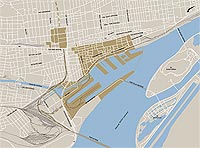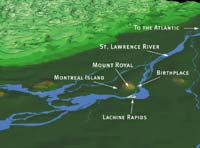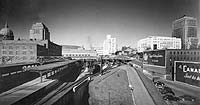|
|
 |
 |
 |
| Click on the map to enlarge it. |
|
 |
 |
|
 |
 |
|
 |
Or when
geography
makes history |
|
 |
|
 |
 |
|
GATEWAY TO A CONTINENT
Montreal occupies a unique geographic
position in North America: it was founded at the exact
spot where the St. Lawrence River becomes impassable
for ships sailing upstream from the Atlantic. The swirling
Lachine Rapids, southwest of the Island, make
it impossible to continue inland. Nor can traffic pass
to the north of the Island, for the des Prairies and
Mille-Îles rivers there are also blocked by rapids.
All this made Montreal a gateway
to the continent, obliging Natives and early European
settlers to make several portages to reach the regions
upstream, via the Outaouais (Ottawa) River and the Great
Lakes, and from there the Mississippi and the Prairie
river systems, as they made their way to the Pacific.
A NATURAL HARBOUR DATING BACK
THOUSANDS
OF YEARS, AND THE BIRTHPLACE OF A CITY
In 1642, the French who had come to
found Montreal settled on the very spot where river
traffic was halted, on a point of land at the mouth
of a little river, the last natural harbour before the
rapids. As archaeological artifacts show, this site
had been known to Natives for millennia. Today Pointe-à-Callière,
the Montréal Museum of Archaeology and History,
stands on the birthplace of Montreal and houses in
situ archaeological and architectural remains, making
them accessible to the public.
|
|
 |
|
 |
 |
|
 |
|
SOON, A EUROPEAN BRIDGEHEAD
IN NORTH AMERICA
Montreal was no sooner founded than
it began building an economy based on the fur trade
with Natives from the "Upcountry." The town
was fortified in the early 18th century, making it also
a military bridgehead for the French empire in
North America and a valuable trading centre for
the fertile agricultural lands around it.
After it was conquered in 1760 by the
British, Montreal retained its role as a fur-trading
centre, but also struck out in new directions. As had
been the case under the French Régime, everything
traded to the north of the English colonies (later the
United States), between the interior of the continent
and Europe, had to pass through Montreal.
...AND LATER A VITAL HUB
The fortifications were torn down in
the early 19th century and, since British imports had
to pass through Montreal, the city became the main regional
trading centre between Lower Canada (now Quebec) and
Upper Canada (Ontario). Its role as a hub was confirmed
once again with the opening of the Lachine Canal in
1825 (bypassing the rapids of the same name) and, not
long afterward, with the building of harbour facilities.
The growing number of commercial buildings was a clear
sign of its important role.
|
|
 |
 |
 |
|
...IN CANADA
Starting in 1850, Montreal became industrialized,
and rapidly grew into Canada's first industrial city.
From the Atlantic to the Great Lakes, it also served
as a distribution centre for all of the newly
confederated Canada in 1867.
Around the same time, a canal was dredged
in the St. Lawrence, so that bigger and bigger trans-Atlantic
vessels could sail all the way up to the harbour. These
were real boom times. The Lachine Canal was widened
to handle the expanding inland shipping traffic, and
the hydraulic energy it provided attracted all kinds
of factories, which set up along its banks.
Ocean-going ships and inland transportation
also came together on the steel rails converging on
Montreal. The very first train bridge ever across the
St. Lawrence was erected at Montreal. The Victoria Bridge
created a direct link with the United States and with
the Atlantic in winter (when the St. Lawrence was frozen),
for freight and passengers. The city became Canada's
main railway centre. Even the old city centre, itself
a transit and administrative centre for both goods and
passengers, underwent a radical transformation.
…ACROSS THE CONTINENT
During the 1880s, the Prairies, and
later the West coast of Canada, were connected by rail
with Montreal, which now openly billed itself as Canada's
metropolis. Two Montreal companies eventually managed
to create uninterrupted routes all the way to the Pacific
coast, accomplishing this feat ahead of all other North
American railways systems of the time (in the United
States, transfers were still needed to get goods and
passengers across the continent). Huge continental railway
stations were built in Montreal to serve the new
Canadian rail systems.
At the turn of the 20th century, the
port once again saw new development, as gigantic facilities
were built to handle Western grain shipments.
Very close by, in the old city centre,
Canada's Wall Street had gradually taken shape
in the 19th century, and now St. James Street (also
known as Saint-Jacques) took on considerable importance
at the dawning of the 20th century. Meanwhile, a new
downtown was springing up where the train tracks had
been extended to the more affluent part of the upper
town, near Mount Royal.
Canadian Pacific, owner of the first
true North American transcontinental railway, established
its head office there. By 1903, the company had a fleet
of transatlantic ships and another fleet in the Pacific,
making it the only railway company in North America
with a transcontinental system. Europe, North and South
America and Asia were now linked through Montreal.
|
|
 |
|
 |
 |
 |

|
 |
|
...AND IN THE MODERN WORLD
In Montreal as elsewhere, the post-war
period brought an unprecedented development boom—indeed,
it could be seen from the late 1930s on, in the new
downtown, with the construction of a modern railway
station. Once again, the railways had proved a valuable
motor of development and innovation. In 1967, the city
also proudly showed its modern face to the world, with
Expo 67, the universal exposition, set on and in the
St. Lawrence.
This spectacular concentration of
urban heritage properties, an eloquent illustration
of Montreal's role as a continental hub, is unique in
its compact nature, more so than in any other North
American metropolis. This is for two reasons. First
of all, the city is located precisely at the breakpoint
for shipping traffic, unlike New York, Boston, Philadelphia
or Baltimore. In addition, Montreal never became a megalopolis
like New York, so its major facilities were confined
to a relatively small area.
|
|
 |
|
|
|